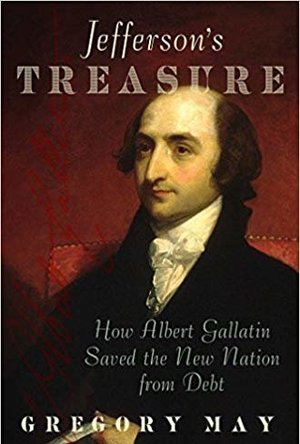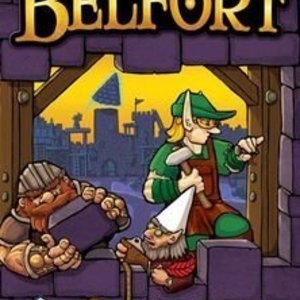
StockWatch - Portfolio Tracking & Stock Quotes
Finance
App
StockWatch is the best App to keep an eye on the stock market, track your portfolios and holdings,...

CoreLogic Property Pro
Business and Productivity
App
Welcome to CoreLogic Property Pro: NZ’s best mobile tool for property & finance professionals when...

BHIM - Bharat Interface for Money
Finance
App
Supported Banks: Airtel Payments Bank | Allahabad Bank | Andhra Bank | Apna Sahakari Bank Ltd. |...
Sassy Brit (97 KP) rated Jefferson's Treasure: How Albert Gallatin Saved the New Nation from Debt in Books
Jun 5, 2019
So who was this man that undid Alexander Hamilton’s fiscal system, rejecting it along with Madison and Jefferson? Because both Presidents did not understand the financial system, they depended on Gallatin to reform it. Gallatin arrived in America in 1790 from Geneva and rose up to become a trusted advisor of the Republicans. Six years before Jefferson was elected President, Gallatin’s Pennsylvania neighbors rebelled against the tax on whiskey. He supported them in principle but opposed the violence that ensued, burning the local tax collector’s house, robbing the mail, and marching on Pittsburgh.
The play “Hamilton” uses revisionist history. The real Hamilton believed in big government and wanted to continue funding federal deficits. He based his theories on the British who used the money to fund their large military conflicts, believing that the ability to borrow endless amounts of money would allow the new United States to become a great nation. Jefferson and Madison thought Hamilton’s system, straight from the British way, was tainted with tyranny. As May noted, “It made the people pay obnoxious taxes in order to fund interest payments on a mounting federal debt and the costs of an expensive military establishment. It shifted money from ordinary taxpayers to the relatively few rich men who held the government’s bonds. That was just the sort of thing that had led Americans to revolt against Britain in the first place.”
May believes, “The hip-hop immigrant hero of the Broadway musical is a myth. The musical might be a great work of art, but is relies on misconceptions of Hamilton. He was not an immigrant, but a migrant within the British Empire. Also, he was not a man of the people, as Gallatin was, but an elitist.”
While Hamilton committed to paying only the interest on the government’s debt, Gallatin committed the government to repaying fixed amounts of the principal each year. He also insisted that the government should never spend more than it earned except in times of war. By slashing federal expenses, Gallatin was able to get rid of the tax on whiskey and abolish the entire internal revenue service.
The Republicans, an agrarian society, distrusted these elitists where two-thirds of the government debt belonged to a few hundred very wealthy men residing mainly in Philadelphia, New York, and other mercantile cities. They saw Hamilton’s plan of collecting taxes from ordinary citizens as a way for a few rich men to become even wealthier. Implementing these excise taxes required government officials to inspect, quantify, and mark the items subject to tax.
The Hamilton system benefited the wealthy debt holders and spectators at the expense of the average taxpayer who had to pay the interest. The government would borrow more than the people could pay. Hamilton tried to hide how much money the government was actually spending and spiraled the debt higher and higher.
This was an important part of the British tax base, and “I wanted to show how unpopular it was. Hamilton and company were resented because they created a tax collection network that affected the lives of ordinary citizens. The excise tax is a form of internal taxation, while tariffs are a form of external taxation that fell on the well to do. Remember mostly the well to do bought imports. The Republicans once they came to power relied on import duties rather than excise taxes.”
May further explained, “When Jefferson and his administration came to power it was Gallatin who got rid of Hamilton’s deficit finance system and cut taxes. By the time he has left office he has repaid half the federal debt and set up a program for repaying the rest.”
Anyone who wants to understand the early economic systems of the Founding Fathers will enjoy this book. It shows how Gallatin, by killing Hamilton’s financial system, abolished internal revenue taxes in peacetime, slashed federal spending, and repaid half of the national debt.
Kristy H (1252 KP) rated I'll Be Your Blue Sky in Books
Feb 26, 2018
I absolutely adore Marisa de los Santos and was really excited to see she had written another book picking up on the characters first introduced in Love Walked In: A Novel and Belong to Me. Both still hold a place of honor on the bookshelves of my home. Still, Goodreads told me it was nearly ten years since I'd read those gems. Considering I can forget a lot of what I've read a few months ago, it took a little remembering and time to get back into the characters. There's a lot to keep track of in the beginning. Still, once I got into the groove, it was like being back with old friends.
Getting to know more about Clare--all grown up now--is lovely. You find yourself drawn to her immediately. Her finance, Zach, made me nervous from the start, and in many ways, the novel can be a little stressful, between Clare navigating Zach, learning about what Edith was up to, and just some of the general topics of the novel. I always know a book is well-written when I find myself getting nervous on the characters' behalf.
The book generally alternates chapters between Clare and the story of Edith, the woman she meets at her wedding venue. Edith's story mainly takes place in the 1940s and 1950s, and I found myself always wishing for more and more of her tale, as she's a fascinating character in her own right. As Clare moves into Edith's old home and starts to investigate the woman's past, we learn a little more about her through Clare and Dev's sleuthing. It's a very effective format, and I found the book surprisingly suspenseful, with several unexpected twists and turns thrown in along the way.
Indeed, I was never really sure where this one was going. It meanders a bit and kept surprising me as it did. There are points where the sadness can be really hard and heartbreaking (in a wow, this novel is incredibly well-written and I feel as if these characters are real way). All the characters fit together so well and come to life before you--no surprise to anyone who has read a Marisa de los Santos novel before. It's so easy to get lost in the world she creates for us. At other times, I just found myself laughing, as Clare and Dev, for instance, could just be so funny and real.
In the end, I just wound up really loving this one. I was along for the ride wherever Clare and her gang were going to take me. I loved her, I loved Edith, and now I'd wait ten years for another book without any issue whatsoever. It's a lovely book about connections and about the family we have and the family we make. It's about love (very appropriate that I finished it on Valentine's Day). Thanks for revisiting these characters, Ms. de los Santos. I didn't know I needed them again, but I'm glad you did. 4+ stars.
I I received a copy of this novel from the publisher and Edelweiss in return for a honest review. More at http://justacatandabookatherside.blogspot.com/

Voice Answer
Business and Reference
App
Voice Answer gives answers on many topics and can assist you with a lot of tasks. The stunning 3D...
Gareth von Kallenbach (980 KP) rated Spider-Man 2 (2004) in Movies
Aug 14, 2019
For many this is a difficult situation that is often accomplished through trial and error marking the difficult transition into adulthood. For Peter Parker (Tobey Maguire), the added pressure of dealing with his dual identity of Spider-Man has driven him to the edge.
Since Peter spends his evenings scouring New York fighting crime, his college studies and job have become seriously neglected. With difficulties paying the bills and making it to class and work on time, Peter has become weary of his life, as Spider-Man has made it close to impossible for him to lead any semblance of normality.
Further hindering Peter’s life is his strong feelings for Mary Jane Watson (Kirsten Dunst), who he keeps at a distance to protect her from reprisals from enemies of his alter ego, though it is causing him endless emotional turmoil to do so.
Faced with losing the woman of his dreams and his lives goals, Peter decides to abandon his alter ego and live life as a normal person allowing his energies to be focused on his studies and pursuit of science.
Peter’s new found freedom is interrupted by the emergence of a new villain named Dr. Octopus (Alfred Molina), who is a brilliant scientist turned evil as a result of an experiment gone awry. The Doctor has four metallic limbs grafted to his body and is capable of amazing feats of strength and copious amounts of destruction and mayhem due to his unrestrained madness.
The cause of the good doctors wrath is to complete the experiment that disabled him and avenge the loss of his wife in the accident that created him. Towards that end, the Doctor needs an abundance of financial assets and a rare fuel source that can only be provided by his former employer Harry Osborn (James Franco). Harry is only to happy to comply as he still blames Spider-Man for the death of his father in the previous film, and promises to supply the Doctor if he delivers Spider-Man to him. The recent failure of the Doctors experiment, have pushed Norman to the edge as what was to be a shining achievement for the company has now left him reeling and looking for answers, straining his relationship with Peter and Mary Jane.
What follows is a wild ride of action, romance, drama, and comedy as the tangled web that is Peter Parker’s life unfolds and it is one wild ride.
“Spider-Man 2” is a solid film that will delight fans of the first film as well as the comic and will provide a welcome presence at the theaters this Summer from the flock of big budget disappointments that have been the norm.
Sam Raimi paces the film at a slow pace to start with and allows the action and pace of the film to unfold. The film never seems in your face as despite the intense action sequences, the film remains a character driven piece as the relationship between Peter and those he cares for are central elements to the film.
As adventure films go, “Spider-Man 2” has a very complex storyline as several mature issues are developed and explored which helps round out the characters from comic book icons to people that you actually care about.
If I had to find fault with the film, and it would be nitpicking, would be that Doctor Octopus did not stand out as menacing a threat as The Green Goblin did in the last film, as he does not embody the same level of fear and evil. That being said, Maguire is amazing as he does a great job of making Peter a realistic character by showing the audience the pain and conflict as well as the joy that Peter experiences being Spider-Man.
The special effects are amazing but never overshadow the human performance and tone of the film, as after all, this is still a story about a regular guy, with regular problems and extraordinary abilities that are part gift and part curse.
The supporting work of Franco and Dunst is solid and there chemistry amongst the leads is evident. The ending of the film sets the stage perfectly for the next chapter in the series and here is hoping that the winning formula continues as “Spider-Man 2” is not only the best comic inspired film ever made, but one of the best films of the year.

The Escape Manifesto: Quit Your Corporate Job - Do Something Different!
Book
Rob, Dom and Mikey were fed up with the corporate treadmill. When they decided to change careers,...
Purple Phoenix Games (2266 KP) rated Belfort in Tabletop Games
Jun 10, 2021
The winner of Belfort is the player who, at the end of seven rounds of play, earns the most Victory Points (VP). Players will earn victory points by having majority of buildings claimed within the five districts of Belfort. To claim a building, players will be shrewdly sending workers to mines, the forest, and various buildings and guilds of Belfort to recruit more workers and earn the ever-important buck to finance these buildings.
Setup is kind of a beast, so I won’t detail everything here. Similarly, I will not be detailing every rule in the book, as there are just too many. But, I will give a general flow of the game so readers may be able to decide if this is a game they must add to their collections.
Once the game is setup and player order is established, each player will complete their entire turn in player order. Players will have many choices available to them on their turn: place workers on various buildings they had previously built, place workers on guild tiles to access powerful abilities, recruit more workers, hire gnomes to unlock certain portions of buildings, gaining more building plans, visiting the trading post to exchange resources, transform normal workers into master workers, and lastly assign workers to gather resources (wood, stone, metal, and gold) in the forests and mines surrounding Belfort.
At certain times during the game players will score their efforts to move up (and down) the VP track. It is at the end of the third and final scoring that the game ends and a victor is crowned.
While this is a very broad and general description of the rules of Belfort, each option listed contains layers of strategic depth that, like all good worker placement games, limits the players’ abilities to go everywhere they like as workers are in limited supply. For those gamers who have never played a worker placement game, this is both excruciating and delicious.
Components. This game boasts way too many components for the box in which is barely contained. I say this with one complete expansion and the promo set of guild tiles included, and the latest expansion on the way. All of the components in this game are stellar. The cards are great. All the cardboard play mats and tiles are great. The worker components and all the wooden bits are super great, AND I didn’t even mind having to sticker my own workers. The best part about the components in Belfort is definitely the art. The team designed an excellent art style for this one, and seeing little hidden jokes within the art makes it all that more interesting to me.
So DOES it hold up after all these years? I think it does. Though I would not consider Belfort an “easy” game to learn, teach, or play at first, after a few rounds players generally catch on and begin to really weigh all their options. This is a great game for think-hungry gamers. This game is conversely a bane for all AP-prone players. I fall right in the middle, but lean towards faster play at the expense of my final score. But that’s the beauty of Belfort and of all worker placement games: there are so many choices that one could easily just try to play so that they visit every location at least once. Now, by doing this the players are also ignoring the true goal of the game: area majority within the districts of Belfort, but if a player isn’t as aggressive or victory-crazed, that’s not a bad thing.
For me, I love Belfort. A lot. Unfortunately for me, during this crazy COVID time, I will not be able to play it much, and was lucky to be able to pull it out recently again after not playing it for several years. But, I always look upon the box fondly and wish I could just bust it out any time I want. Maybe someday someone will create solo rules for it and I can enjoy it that way. My wife is not a fan, but also she’s not really a fan of games that are longer than an hour generally. I cherish this game, and am quite happy to have it in my collection.

Corporate Sustainability, Social Responsibility and Environmental Management: An Introduction to Theory and Practice with Case Studies
Book
This book provides a concise and authoritative guide to corporate social responsibility (CSR) and...



